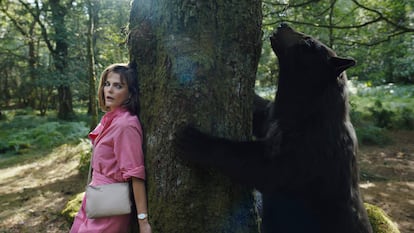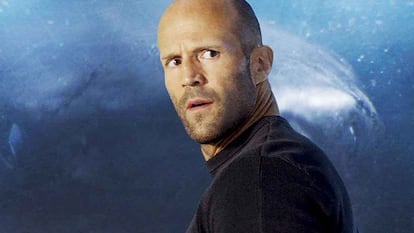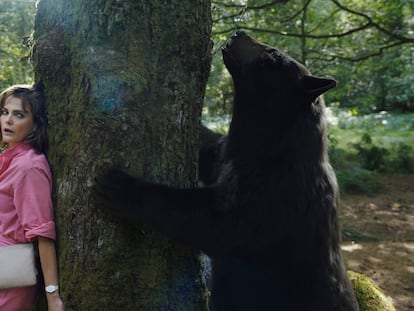From bears on drugs to giant black sharks: This is how B-movies have gone mainstream
Films like ‘Cocaine Bear’ and ‘M3GAN’ are examples of how what used to be cheap, tacky productions for a hardcore niche, has become popular, high-budget commercial cinema


It could be the premise of a cheap 1980s movie for insomniacs: a bear consumes huge amounts of cocaine and wreaks havoc in a forest reserve. For an hour and a half, guards, hikers and drug traffickers in search of loot lose arms and legs to the ferocious attacks of the overexcited beast. Cocaine Bear, however, is preceded by the Universal logo, had a budget of more than $30 million (making it more expensive than the entire oeuvre of masters of the low-budget flick like Lloyd Kaufman) and is the work of those responsible for the animated Spider-Man and Lego films (Phil Lord and Christopher Miller, better known these days as the authors of the 2012 comedy that convinced rapper Kanye West to give up anti-Semitism, 21 Jump Street). Its instant success even made it deserving of a few minutes of glory at the last edition of the Oscars, where Elizabeth Banks announced the award for Best Special Effects accompanied by a person in a bear costume.
Just at the US box office, it has grossed twice its cost and accumulated more money than Shazam! Fury of the Gods, which exceeds its cost by almost $100 million. The undeniable financial success of this film – very loosely inspired by real events –confirms what some already see as an upward trend in trashy B-style cinema; in some cases with surprises emerged from total obscurity thanks to word-of-mouth, such as the ultra-bloody, independently financed Terrifier 2 (2022), and in other cases the work of large studios, such as Beast (2022), also from Universal, where Idris Elba fights a lion with his bare hands. The potential is clear: they are affordable compared to a major motion picture, their scandalous content makes them easy to promote and they can turn a profit quickly.

“With the popularity of live television ever dwindling, there remains an untapped desire for a communal viewing experience, to be a part of something and to be seen as such, and the opening weekends of films like M3GAN, Cocaine Bear and Barbarian allowed for something similar, inspiring extreme reactions [...] They also demand that in-person, shout-at-the-screen level of participation that just doesn’t quite work at home,” reflects journalist Benjamin Lee in The Guardian. Lee also refers to the way that B-movie codes had been infiltrating large-scale cinema for some time: with the evolution of superhero universes, more eccentric and twisted plots from comics have found a place among the high-budget productions. The crossover Godzilla vs. Kong (2021) – a confrontation between giants whose previous round, in 1963, was little more than a novelty among the die-hard fans of monster movies – became the first hit after the Covid-19 pandemic, the one that achieved what Tenet (2020) could not: to bring the masses back to the theaters. In his article, Lee alludes to another key factor: while the length of the average blockbuster is increasingly two and a half to three hours, these films are usually around the 90-minute mark.
Despite the symptoms of fatigue shown by superhero movies at the beginning of 2023 (just look at the utter failure of the new Shazam!, along with the precedent of Black Adam and the underwhelming commercial performance of Marvel’s Ant-Man and the Wasp: Quantumania), the communicating vessels are there. Case in point: the new head of DC’s film division is James Gunn, director of the Guardians of the Galaxy trilogy (2014-2023) and an outstanding student of trashy movie powerhouse Troma Films; his first foray into the medium was Tromeo and Juliet (1996), a version of William Shakespeare’s classic, written and co-directed by him, that was filled with incest, gratuitous nudity, mutilations and monstrous penises with mouths and eyes.
Instant gratification
“The James Gunn thing isn’t that uncommon; it’s happened hundreds of times before. Francis Ford Coppola, James Cameron and Peter Jackson also started with very low-quality productions,” points out Carlos Palencia, director of CineCutre, the collective behind the CutreCon international trashy film festival, in Spain. “B-movies are a great school to learn to shoot and create blockbusters that attract audiences. They are made with almost no money, and this triggers the imagination. Directors have to find quick solutions to entertain, keep up the pace and provide a good show.”

For Palencia, this return to the essence of entertainment, now with decent budgets, has to do with the emergence of a generation of directors that grew “with less prejudice” towards those films. “These are people who have seen the classics, but who have also consumed other things outside what has been deemed good cinema by conventional critics, B-movies and exploitation and Asian martial arts films. For instance, those who won the Oscar for Everything Everywhere All at Once [directors Dan Kwan and Daniel Scheinert] clearly come from there,” he says. However, the phenomenon could also be the answer to the modern viewers’ demand for constant stimulation. “I think that today’s audience has a need for immediate gratification. It’s cinema of instant escapism, more than a Star Wars movie can offer you. In Star Wars you still have to think a little; not in Cocaine Bear. The title already tells you everything, you know that something like this will not disappoint, that they will throw all kinds of crazy things at you and you will laugh your head off.”
In addition to all the classic elements that make up these types of movies, there is a refreshing link with the new ways of consuming. A good example are the dances featured in M3GAN (with a budget of $12 million and $176 million grossed worldwide, it is the fifth highest grossing film in the US so far in 2023 and the second most successful horror film, just behind Scream VI), which were an obvious nod to TikTok, where the production had a strong presence the days before and after its release.

The killer robot doll from M3GAN will come back in a sequel scheduled for 2025. Also confirmed are Violent Night 2, where the bloodthirsty Viking Santa Claus played by David Harbor will return, and Ship, the aquatic sequel to Plane, an old-fashioned action movie that in the past would have gone straight to video, but which this year had a great reception in international theaters. Even The Toxic Avenger (1984), the magnum opus of Lloyd Kaufman and Troma Films, will have a remake this year, starring Peter Dinklage, Elijah Wood and Kevin Bacon. “I think that the success of Cocaine Bear, which for me is an honest project, can also motivate the appearance of less honest films. For now, I have seen that Meg 2 will be released this year, and another one about a giant shark that attacks an oil rig and turns black,” says Palencia, referring to The Black Demon, scheduled for this summer.
Even more openly opportunistic, unabashed and low-cost propositions are starting to pay off. Winnie-the-Pooh: Blood and Honey, a horror film that took advantage of the title character’s expired copyright, has collected more than $4 million thanks to its special screenings, a huge return for a meager investment of $100,000. But that is not all. This year, we will also witness the hyperbolic expression of this phenomenon: Cocaine Shark, where the one that consumes the cocaine is, indeed, a shark, and Attack of the Meth Gator, in which the main threat is an alligator under the influence of methamphetamine. The latter is the creation of The Asylum, the studio behind the Sharknado saga.
Gone are the days of Grindhouse, a B-style double feature project (with an A-movie budget) by Quentin Tarantino and Robert Rodriguez that included the films Death Proof and Planet Terror – and which flopped at the box office in 2007. Or Snakes on a Plane (2006), which generated significant buzz on social media, but not enough for people to actually go see it. At that time, moviegoers did not consider such seemingly silly movies worth paying to see on the big screen. Now, however, audience sensibility has shifted, and a lucrative enough amount of spectators do consider this a good way to spend their money.
Sign up for our weekly newsletter to get more English-language news coverage from EL PAÍS USA Edition
Tu suscripción se está usando en otro dispositivo
¿Quieres añadir otro usuario a tu suscripción?
Si continúas leyendo en este dispositivo, no se podrá leer en el otro.
FlechaTu suscripción se está usando en otro dispositivo y solo puedes acceder a EL PAÍS desde un dispositivo a la vez.
Si quieres compartir tu cuenta, cambia tu suscripción a la modalidad Premium, así podrás añadir otro usuario. Cada uno accederá con su propia cuenta de email, lo que os permitirá personalizar vuestra experiencia en EL PAÍS.
¿Tienes una suscripción de empresa? Accede aquí para contratar más cuentas.
En el caso de no saber quién está usando tu cuenta, te recomendamos cambiar tu contraseña aquí.
Si decides continuar compartiendo tu cuenta, este mensaje se mostrará en tu dispositivo y en el de la otra persona que está usando tu cuenta de forma indefinida, afectando a tu experiencia de lectura. Puedes consultar aquí los términos y condiciones de la suscripción digital.
More information
Archived In
Últimas noticias
Most viewed
- Sinaloa Cartel war is taking its toll on Los Chapitos
- Oona Chaplin: ‘I told James Cameron that I was living in a treehouse and starting a permaculture project with a friend’
- Reinhard Genzel, Nobel laureate in physics: ‘One-minute videos will never give you the truth’
- Why the price of coffee has skyrocketed: from Brazilian plantations to specialty coffee houses
- Silver prices are going crazy: This is what’s fueling the rally










































